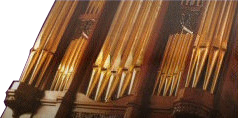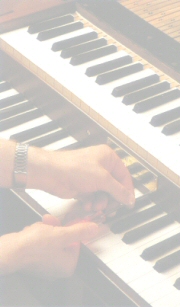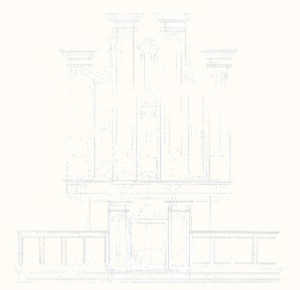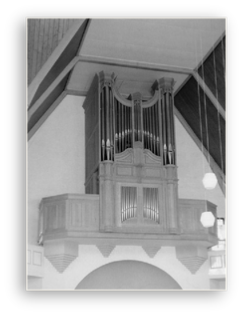*) Sesquialtra Bass: 1 ³/5, 1 ¹/3, 1
**) Cornet Treble: 2 ²/3, 2, 1 ³/5
Great to Swell, Swell to Pedal, Great to Pedal, Swell octave
Wind pressure: 68 mm/WK.
Temperament: Young
The instrument in the Gereformeerde kerk at Wirdum was built
in 1842 by the organ-builder N.Fisher. The inscription of both its
precise year of construction and the name of its builder were
found during the latest restoration in 1991. Almost all the pipework
was made by one Wilson whose name often appears.
Originally, the instrument had a keyboard compass starting from GGG which was characteristic for that period. It is still unknown for which purpose it was originally built. In 1893 and during the 1960s the organ was partly modified. The original keyboard compass from GGG was reduced to CC while also some stops were exchanged.
During the resent restoration, the three stops placed in 1893 were replaced by a Trumpet (Shalter, 1873), a new Sesquialtra-Cornet (reconstruction) as well as a Bourdon 16 ft. The intention of these changes was to restore the sound of the instrument as much as possible to the early-victorian principle. A Double Diapason 16 ft. was also added to the Swell Organ. The Swell soundboard was replaced on its original, elevated level.
The original organ case got lost probably around the turn of the past century (19th-20th). Due to the poor quality of the existing casework as well as the new situation in Wirdum, the organ was provided with a new case. For this purpose, the organ restorer F.R. Feenstra, made use of an existing, English front that was already in his possession. This Front possibly originates from an organ which was made for Napoleon III. As the original old pipework remained virtually undamaged during the various modifications, this instrument appears to be a fine example of early Victorian organ building in England.
After church closure in 2002, the instrument was transferred to Bergschenhoek.





 Contact
Recordings
Previous page
Contact
Recordings
Previous page







